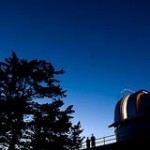Tag Space & astronomy
Scientists hope to mimic nature’s dynamos
In the cosmos, all celestial objects - planets, stars, galaxies and clusters of galaxies - have magnetic fields. On Earth, the magnetic field of our home planet is most easily observed in a compass where the needle points north.
Curiosities: How big is space?
Space is probably infinite, but we can see only the part that contains stars or galaxies whose light has been able to reach us, says…
Curiosities: How many galaxies have humans discovered?
“We don’t know,” says Ed Churchwell, professor of astronomy. “We know it’s a very large number.” It’s in the hundreds of billions, Churchwell…
Planet Trek offers chance to bike or walk through scaled-down solar system
Dane County residents have a new way to appreciate the solar system, thanks to Planet Trek Dane County, which offers pedestrians and bikers a chance to discover the 11 biggest objects in the solar system at the correct scale of size and distance.
Curiosities: Why do we need leap days?
Leap days appear every four years or so, including this year, and they are needed because one orbit around the sun does not occur in an exact number of days, says Jim Lattis, director of UW Space Place, in the UW–Madison astronomy department.










